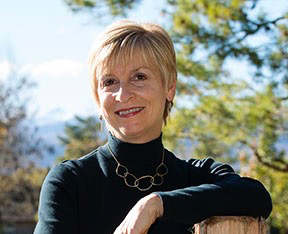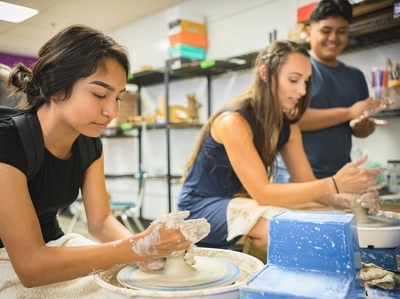Finding Our Why: Voices of Change-Makers
Topics
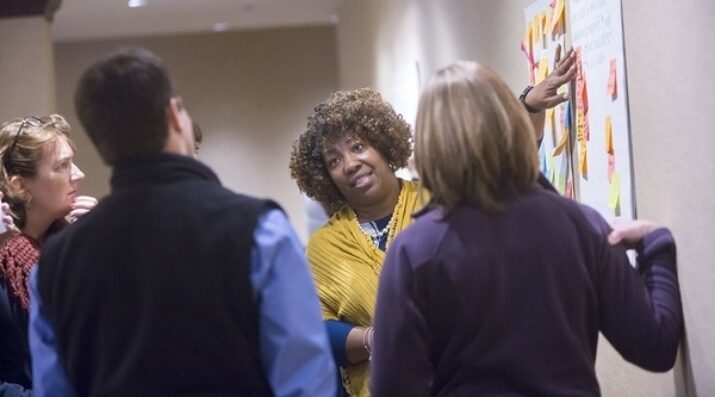
Today’s learners face an uncertain present and a rapidly changing future that demand far different skills and knowledge than were needed in the 20th century. We also know so much more about enabling deep, powerful learning than we ever did before. Our collective future depends on how well young people prepare for the challenges and opportunities of 21st-century life.
Practitioner's Guide to Next Gen Learning
The "whys" that inspired participants in a recent School Design Institute to spend their weekend living the change they want to see in education.
It’s a Saturday morning in early November. All of the hotel’s meeting rooms are full, as this conference center in Framingham, MA, is hosting several events at once. Even so, the atmosphere in the hallways is subdued. From behind closed wooden doors drifts an occasional smattering of polite applause or—more likely—the lone voice of a presenter talking about a new pharmaceutical product.
Except for one room at the bottom of the stairs. It’s a much noisier room, a space full of excited voices talking all at once: storytelling, giving and receiving feedback, and collaborating to create something new and powerful for their students, schools, and communities.
Two men in suits descend the stairs and pause outside the door. “What’s going on in there?” asks one. The other replies, “I heard they’re school designers.”
The man was right—behind those not-quite-soundproof doors were seven teams of educators, students, parents, and even some industry professionals, all participating in a School Design Institute (SDI). This was the fourth weekend-long learning design and re-design experience hosted by Mass IDEAS, a Massachusetts-based initiative of Next Generation Learning Challenges, with funding provided by the Barr Foundation and the Nellie Mae Education Foundation.
The assembled teams represented middle schools, high schools, rural and urban communities, established districts, and new charters—some still in the planning stages—from across Massachusetts. All of these teams are engaged in the work of rethinking and redesigning education so that all learners can succeed and thrive in their futures. Each group arrived with a unique problem of practice and, with the support of an expert coach and fellow participants, collaborated to design a solution to pilot in their schools. That’s an ambitious goal for two days, one that requires considerable effort and strong motivation.
One key understanding that has emerged from NGLC’s partnerships with schools and districts who embody next gen change principles is this: everyone engaged in the work to transform learning for equity and student success must find a compelling and inspiring why for change, both collectively as a learning community and individually—as an educator, parent, student, or citizen.
This edition of Friday Focus: Practitioner’s Guide to Next Gen Learning shares some of the individual whys that inspired SDI participants to spend their weekend living the change they want to see in education.
Why Does Education Need to Change?
Gary Reese, superintendent of schools, Westport Junior Senior High School team: I think schools are operating the way they did 50 years ago, and we know that too many students are not able to succeed in that model.
Greg Pavlisko, assistant principal at Esek Hopkins Middle School (Providence, RI), Leading Edge Charter School team: A lot of kids are being left behind. For so many years I’ve seen bureaucracy in a lot of areas just layered and layered and layered—that needs to be torn down so we can rethink what our students actually need and not what we think they need.
Carleen Harring, grade twelve student, Essex North Shore Agricultural and Technical School (ENSATS) team: Schools need to change to be a healthy environment for students to grow and build on their education—a place to escape, where they can be with people they know care about them and are there to make sure everything is OK.
Beth Turenne, parent, Westport Junior Senior High School team: Schools need to evolve. When you think about the world we live in today, with technology and politics and government and everything that’s surrounding us, I think schools need to keep up with that type of pace, but at the same time still provide that foundation for children to grow and thrive, to really live and prosper.
Stacy Stewart, principal at Belmont-Cragin Elementary (Chicago, IL), coach for the Jabish Brook Middle School team: My big reason for why is why not? The biggest lever in helping children realize the beauty of their dreams is having adults that have a relentless commitment to giving them the tools and strategies they need to be successful—to really know who they are and what they can accomplish in our school communities. We don’t look at students as anything more than a statistic. We have to debunk that. Every child in our school district and in our country needs to be successful, and it is up to us to do it. Traditional education is not meeting the needs of all learners. If kids are not given rich experiences that tap into their assets and develop growth mindsets, then we are doing them a disservice. It’s our personal responsibility as educators to make this happen for every child.
Bailey McCaul, grade twelve student, ENSATS team: I think schools need to change to become a place where students can have a say in their education so they can mold it to follow the career path they want for their future.
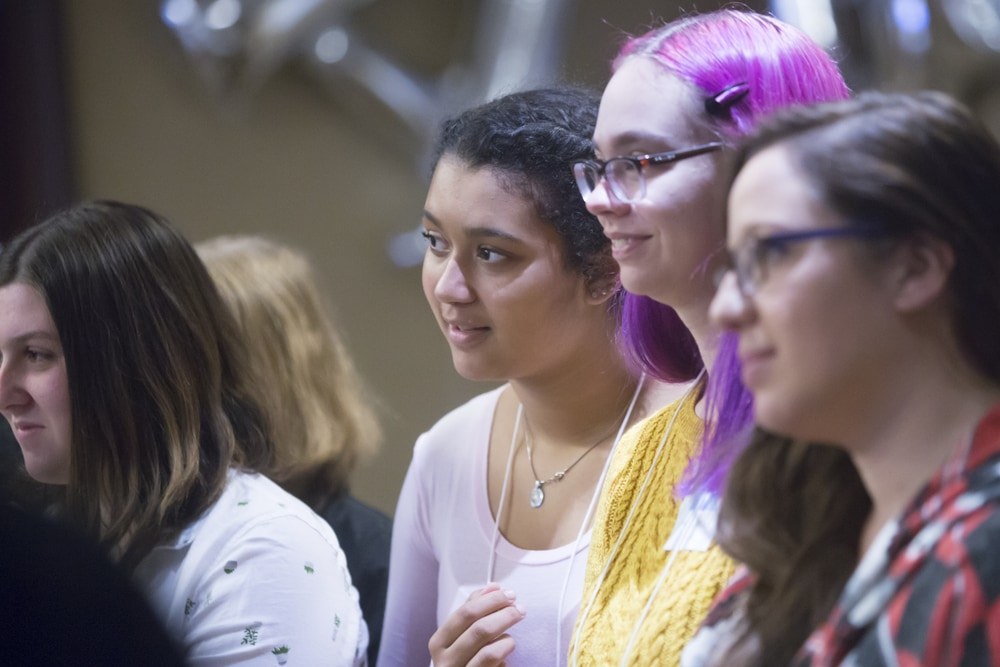
Student representatives from the ENSATS team (from left to right): Jahnaya Stone, Bailey McCaul, and Carleen Harring
Why Does My School Need to Embrace Change?
Stephanie Davies, math teacher, Jabish Brook Middle School team: For me, college had a big impact to see that it’s not just about the content. What can I do that’s outside of just math to really teach these kids the skills that they can transition with and grow with? I see in middle school that these students are twelve years old, and they have so much potential in them to harness the leadership they don’t even know they have. As a team our focus is to harness that and figure out ways to teach them something that is not taught in the curriculum.
Shawn Fortin, assistant superintendent for teaching and learning, Jabish Brook Middle School team: We are working on student leadership capacities and that, for me, is as simple and complex as this: I believe that every student has the capacity to make a positive impact on the world and that it’s our job to help them do that. Certainly there are some people who are doing that with purpose, and there’s components of school that develop leadership capacity. But when I say “with purpose,” it would mean a thoughtful integration of those competencies with the content areas and—if you were doing student council or with our community service requirement—specifically calling out “here’s the learning.” Building on things that are going in the right direction and which have a lot of positive supports and reasons for why they happen, but explicitly connecting them to intended outcomes that tie back to developing leadership.
Jim Spillane, assistant principal, Galvin Middle School team: We have recent surveys from our students that indicate that 51 percent are not interested or engaged in teaching and learning. It’s a very high number and an alarming number, so we are really digging deeper into how can we transform the student learning experience, including teaching and learning to better engage all students.
Nicole Culhane, math co-teacher, Milford High School team: Our school has a very large community of EL (English learners), and it is growing very quickly. We really want to be able to support those students—all students at our school. With this growing population we are trying to help them achieve their goals. We are hoping to find a method of supporting students’ social emotional learning in our district and making sure they feel welcome here, learn content as well as English, and earn a diploma.
Bailey McCaul: I want to increase student voice and choice. I want everyone to be free and have opportunities like I’ve had at Essex North Shore—to find that career path and to work with their communities to really explore what’s possible.
Jeff Monahan, founder and director, Proper Villains (branding and creative studio), Boston Advertising and Design Charter High School team: We are trying to build a high school because we have a massive problem of underrepresentation of people of color in our industry; we have a very active and successful collegiate internship program, but we know that the problem exists in earlier grades, so we believe the right place to try to solve the problem is at the high school level.
Why Am I Here This Weekend?
Greg Pavlisko: I aspire to be an agent of change and help people see things differently, as well as shake up the current system. I have a seven-year-old and a six-year-old at home, and I think about ten years from now when they might go to college. Education might be the same, but I like to think not. I want to help inspire more radical thinking in education than what we’ve got currently.
Carleen Harring: I want to make sure everyone has opportunities like I’ve had at high school, that schools are a safe place where people feel comfortable and that it’s a place where they can explore and learn.
Fernando Borges, ESL teacher, Milford High School team: I am hoping for different strategies and ideas we can apply in Milford. We have a lot of EL students and immigrants, and we have to come up with new ways to help these students succeed in the U.S.
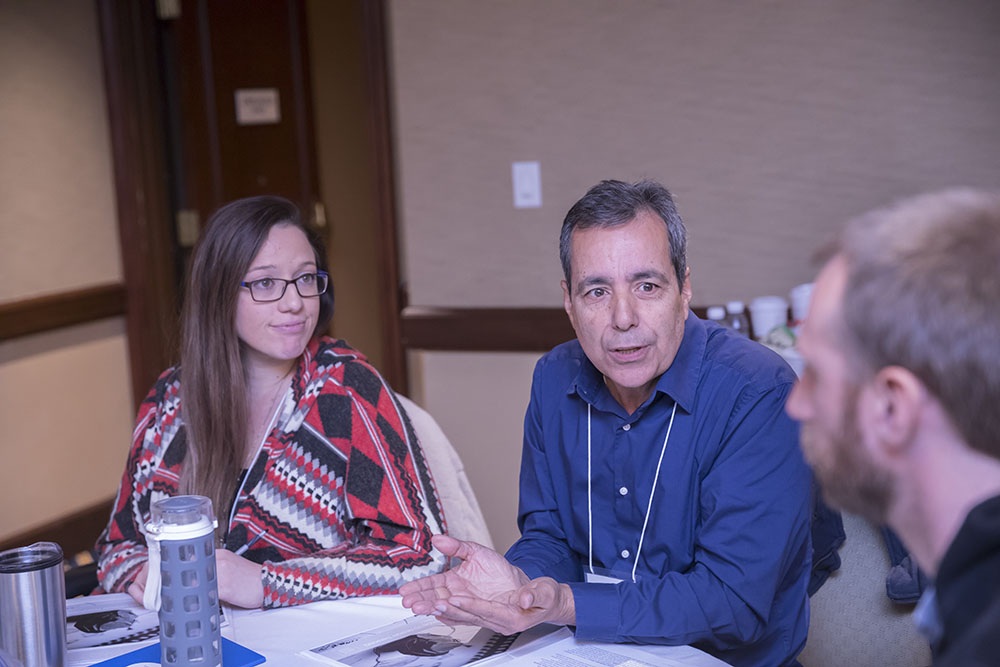
Nicole Culhane and Fernando Borges from the Milford High School team discuss their problem of practice with their coach, Andrew Pratt, from CityBridge Education in Washington, D.C.
Jim Spillane: This weekend is really serving as a ground-breaking time for us, a gathering of data. We have assembled a great team. We have the principal of the school, several teachers, a parent, a student from our school with us, and we’re working with a great coach. We really want to formulate a game plan of how we attack this [problem with engagement]. We’re not really looking for solutions yet—right now we’re identifying how we can gather more information and data from our students and that will help drive our next steps.
Jeff Monahan: We are hoping to get a number of different things out of this weekend. We are hoping to get learnings about what it will take to get [Boston Advertising and Design Charter High School] built. We are just in the beginning of our journey—the team is about nine months into its work—and we know this will be a collective effort with a whole group of people outside of our own specialty and experience. As we’ve said to many of the people here over the course of the weekend, we recognize that we are a team of industry professionals. We are not educators, and we are looking to learn from people who know far better than we do.
Stephanie Davies: Our kids are not getting the life skills they need in terms of leadership, collaboration, and communication, so that’s part of what inspired me to come. It’s been on my mind for the last few years, so I saw this as an opportunity. I had been racking my brain for a way to narrow it all down, and student leadership just clicked with me.
Jahnaya Stone, grade eleven student, ENSATS team: I really want to be part of helping the school grow and start over and have new ideas. There are a lot of students involved now, and I’m really excited to be one of the first ones working on changing things.
Stacy Stewart: My reason for working with a team at the SDI is my own personal commitment to making a change across the country. If you are to be part of the solution, then it’s up to you to support in any way you can. As I help other schools, it also helps me to better reflect on challenges I may be facing in my school as a leader. In order for you to be a lifelong learner—and you want your teachers to be that—then you have to model that as a principal. There’s also things I want to do and think about and tackle, so my selfish reason is I am learning vicariously from the coaches I am working with and also from the participants, so this is a lot of fun for me. I am just a nerd at heart.
Beth Turenne: I’m here this weekend because I love my kids, and I’ll do anything for them. I’ve been fortunate enough to have a career where I was able to grow and develop over time, and I think about the foundation that helps kids live a great life. That’s what all parents want—to set their kids up for a great future.
Resources
- This story about next gen change management at Mission Vista High School addresses the importance of finding a why for change.
- Engaging the community to redesign learning is the focus of this story about a project-based learning day in Cohasset, MA, a team that participated in a past SDI weekend.
- This story about the Assessment for Learning Project offers insights on the potential role of student voice in the design of public education systems.
- This Harvard Business Review article by Rosabeth Moss Kanter explores the top ten reasons people resist change and the importance of shared planning and ownership in the change process.
- Taken together, MyWays Report 2, 5 Roadblocks to Bootstrapping a Career, Report 3, 5 Decisions in Navigating the Work/Learn Landscape, and Report 4, 5 Essentials in Building Social Capital, present the “5-5-5 Realities” confronting adolescents in a world of accelerating change.
Photos courtesy of Paul Schnaittacher for Mass IDEAS.

